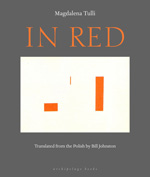

Archipelago Books, paperback, 9781935744085
Magdalena Tulli's In Red (W czerwieni 1998) uncovers the pattern of life in the Polish town of Stitchings: it is a pattern that recurs three times within the first half of the twentieth century. The pattern varies by season and generation, but each recurrence is woven with similar threads of growth and greed, hope and despair, and the constant looming presence of war and death. The introductory sentence to each section hints at the different shadings of each section:
Anyone who makes it to Stitchings appreciates its misty grayness and the moist warm breeze in which desires flourish so handsomely. (56)
Whoever wishes to leave Stitchings can avail himself of two methods. (106)
Tulli's protagonist must be seen as the town itself, and the major characters are the three major businesses in town (along with their familial owners): Loom & Son, the makers of corsets and collars and operator of depots; Neumann's, the phonograph record manufacturer; and Strobbel's Works, the porcelain factory. The generations change, and the products are modified for changes occasioned by war and modern life. But although power is tightly controlled, the inevitability of disintegration slowly unravels the fabric of the town.
It begins when Stefania Neumann delays accepting the proposal of a young lieutenant, and he is sent off to the battlefront. Stefania continues to sew her trousseau until she learns that he has sold the engagement ring to pay off his gambling debts. Despairing and distracted, she picks up red thread and embroiders a rose among the white lilies. Frightened at the sight, she picks out the red silk threads, and they are borne by breezes throughout the town. The fate of every man on whom a red thread lands is to die in the war.
As do so many magical-realist tales, In Red couches its horrors in folkloric devices that soften the impact upon the readers—at least initially. We don't have to recoil in pain or shrink from the gory details, but we are brought to understand how those who loved idealistically turn rigid and cold, how those whose hearts stop beating refuse to die, and how easily those who were exploited can become the exploiters.
In Red is mesmerizing—Tulli stitches her readers into her town, which at the end of the fable goes
up in flames. When I finished the book, I had been transported into a strange, yet oddly familiar place, and
I knew I had to read the book a second time to begin to understand how Tulli explores and exercises the power
of storytelling.
Magdalena Tulli (b. 1955) has written three other books translated into English by Bill Johnston:
Dreams and Stones, 2004 (Sny i kamienie 1995); Moving Parts, 2005 (Tryby 2003) and
Flaw, 2007 (Skaza 2006), which was reviewed
in the first issue of Belletrista. She works as a psychologist and translator in Poland.
